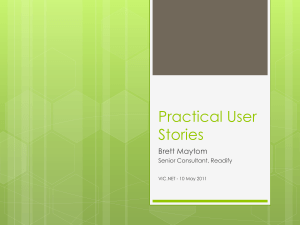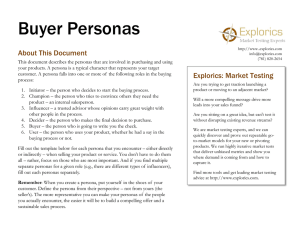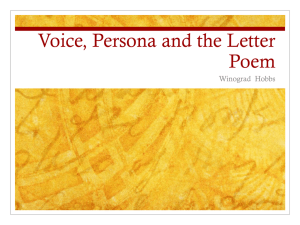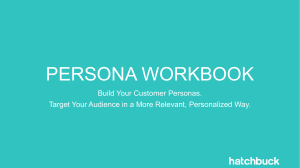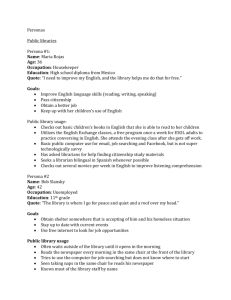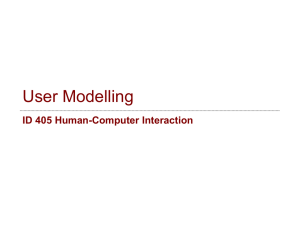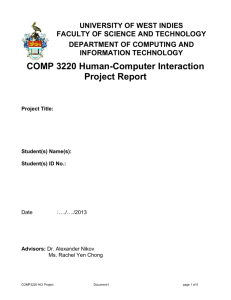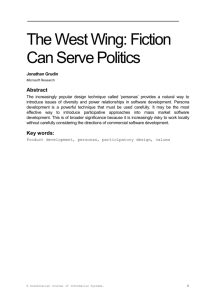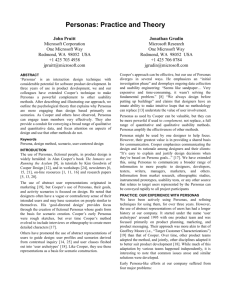Developing User Personas
advertisement
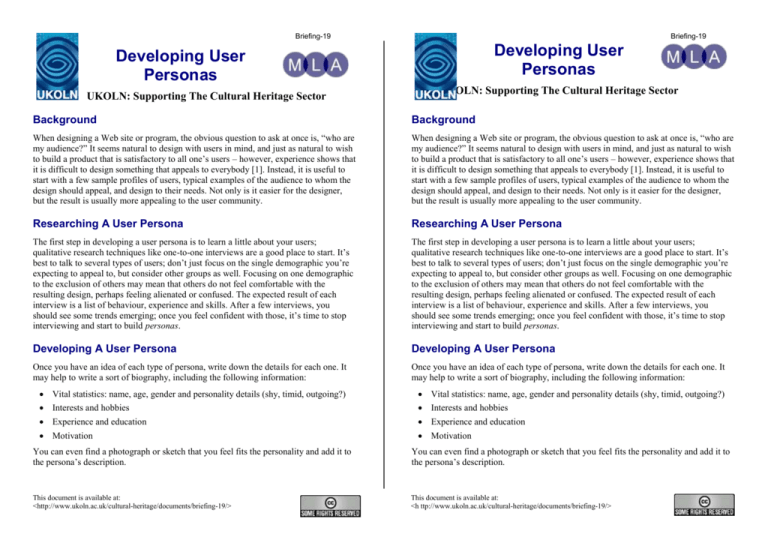
Briefing-19 Briefing-19 Developing User Personas Developing User Personas UKOLN: Supporting The Cultural Heritage Sector UKOLN: Supporting The Cultural Heritage Sector Background Background When designing a Web site or program, the obvious question to ask at once is, “who are my audience?” It seems natural to design with users in mind, and just as natural to wish to build a product that is satisfactory to all one’s users – however, experience shows that it is difficult to design something that appeals to everybody [1]. Instead, it is useful to start with a few sample profiles of users, typical examples of the audience to whom the design should appeal, and design to their needs. Not only is it easier for the designer, but the result is usually more appealing to the user community. When designing a Web site or program, the obvious question to ask at once is, “who are my audience?” It seems natural to design with users in mind, and just as natural to wish to build a product that is satisfactory to all one’s users – however, experience shows that it is difficult to design something that appeals to everybody [1]. Instead, it is useful to start with a few sample profiles of users, typical examples of the audience to whom the design should appeal, and design to their needs. Not only is it easier for the designer, but the result is usually more appealing to the user community. Researching A User Persona Researching A User Persona The first step in developing a user persona is to learn a little about your users; qualitative research techniques like one-to-one interviews are a good place to start. It’s best to talk to several types of users; don’t just focus on the single demographic you’re expecting to appeal to, but consider other groups as well. Focusing on one demographic to the exclusion of others may mean that others do not feel comfortable with the resulting design, perhaps feeling alienated or confused. The expected result of each interview is a list of behaviour, experience and skills. After a few interviews, you should see some trends emerging; once you feel confident with those, it’s time to stop interviewing and start to build personas. The first step in developing a user persona is to learn a little about your users; qualitative research techniques like one-to-one interviews are a good place to start. It’s best to talk to several types of users; don’t just focus on the single demographic you’re expecting to appeal to, but consider other groups as well. Focusing on one demographic to the exclusion of others may mean that others do not feel comfortable with the resulting design, perhaps feeling alienated or confused. The expected result of each interview is a list of behaviour, experience and skills. After a few interviews, you should see some trends emerging; once you feel confident with those, it’s time to stop interviewing and start to build personas. Developing A User Persona Developing A User Persona Once you have an idea of each type of persona, write down the details for each one. It may help to write a sort of biography, including the following information: Once you have an idea of each type of persona, write down the details for each one. It may help to write a sort of biography, including the following information: Vital statistics: name, age, gender and personality details (shy, timid, outgoing?) Vital statistics: name, age, gender and personality details (shy, timid, outgoing?) Interests and hobbies Interests and hobbies Experience and education Experience and education Motivation Motivation You can even find a photograph or sketch that you feel fits the personality and add it to the persona’s description. You can even find a photograph or sketch that you feel fits the personality and add it to the persona’s description. This document is available at: <http://www.ukoln.ac.uk/cultural-heritage/documents/briefing-19/> This document is available at: <h ttp://www.ukoln.ac.uk/cultural-heritage/documents/briefing-19/> Why User Personas? Why User Personas? The intent behind a user persona is to create a shared vocabulary for yourself and your team when discussing design questions and decisions. User personas provide easy-toremember shorthand for user types and behaviour, and can be used to refer to some complex issues in a simple and generally understood way. Sharing them between management and development teams, perhaps even with funders, also provides a useful avenue for effective communication of technical subjects. Furthermore, it is much easier to design for a persona with whom one can empathise than for a brief, dry description of user demographics. The intent behind a user persona is to create a shared vocabulary for yourself and your team when discussing design questions and decisions. User personas provide easy-toremember shorthand for user types and behaviour, and can be used to refer to some complex issues in a simple and generally understood way. Sharing them between management and development teams, perhaps even with funders, also provides a useful avenue for effective communication of technical subjects. Furthermore, it is much easier to design for a persona with whom one can empathise than for a brief, dry description of user demographics. It is good practice, when making design decisions, to consider each user persona’s likely reaction to the result of the decision. Which option would each user persona prefer? It is good practice, when making design decisions, to consider each user persona’s likely reaction to the result of the decision. Which option would each user persona prefer? User personas can also feed in to discount usability testing methods such as the cognitive walkthrough, saving time and increasing the effectiveness of the approach. User personas can also feed in to discount usability testing methods such as the cognitive walkthrough, saving time and increasing the effectiveness of the approach. Finally, the research required to create a user persona is an important first step in beginning a user-centred design process, an approach that focuses on supporting every stage of the development process with user-centred activities, which is strongly recommended in designing for a diverse user group. Finally, the research required to create a user persona is an important first step in beginning a user-centred design process, an approach that focuses on supporting every stage of the development process with user-centred activities, which is strongly recommended in designing for a diverse user group. Conclusions Conclusions User personas are a useful resource with which to begin a design process, which allow the designers to gain understanding of their users’ expectations and needs in a cheap and simple manner, and can be useful when conducting discount usability testing methods. Additionally, they make helpful conversational tools when discussing design decisions. User personas are a useful resource with which to begin a design process, which allow the designers to gain understanding of their users’ expectations and needs in a cheap and simple manner, and can be useful when conducting discount usability testing methods. Additionally, they make helpful conversational tools when discussing design decisions. References References 1. The Inmates are Running the Asylum, Alan Cooper, ISBN: 0672316498 Produced by UKOLN: a national centre of expertise in digital information management For further information see <http://www.ukoln.ac.uk/> 1. Sep 2008 The Inmates are Running the Asylum, Alan Cooper, ISBN: 0672316498 Produced by UKOLN: a national centre of expertise in digital information management For further information see <http://www.ukoln.ac.uk/> Sep 2008
